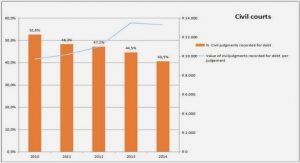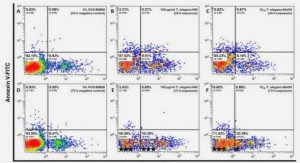Get Complete Project Material File(s) Now! »
Solar Thermal Collector Systems
Solar thermal systems convert the radiant energy from the sun into thermal energy of the heat transfer fluid via solar thermal collector systems of different configurations. The solar thermal collector systems are classified as non-concentrating and concentrating solar collectors [5]. The non-concentrating collectors, which use the same surface for intercepting and absorbing solar radiation, achieve low temperatures due to high thermal losses, which increase with the absorber surface area. Such collectors systems include flat-plate collectors, solar ponds, and solar chimneys and evacuated tube collectors [13]. The concentrating solar collectors work by interposing an optical device between the solar radiation and the energy-absorbing surface [5]. They rely mostly on the beam component of solar radiation, since the diffuse component cannot be concentrated. The concentrators must therefore track the apparent daily motion of the sun across the sky to achieve high concentration of the beam radiation. Two different methods through which the concentrators track the sun’s apparent motion were reported in [5, 32]. The first one is the altazimuth method, which requires the tracking device to turn in both altitude and azimuth. This method enables the concentrator to follow the sun exactly. The second one is the one-axis tracking in which the collector tracks the sun in only one direction either from east to west or from north to south. The concentrating collectors can achieve higher temperatures ranging from 200 °C to 1000 °C or even higher, suitable for steam generation for electricity generation via thermodynamic cycles [33]. They can achieve greater thermal efficiency due to small heat loss area relative to the receiver area. Also, for the fact that higher temperatures permit more thermodynamically efficient energy-conversion cycles, most large-scale solar thermal collectors are of the concentrating type [34].
Major Components of the Linear Solar Concentrators
The major components of a linear focusing solar concentrator are the collector support structures, the reflectors and the receiver [74]. The tracking device tracks the sun such that the incident radiations are concentrated on the focal line of the receiver tube. The support structures are the frames for mounting the reflector mirrors and to ensure that the mirrors are optically aligned with the receivers under wind loading conditions. They are designed to have adequate torsional rigidity to withstand twisting due to wind load, deformations due to collector weight and thermal stresses due to temperature differential and that of the receiver [50]. The reflector mirrors for parabolic trough collectors are made from low-iron float glass of about 4mm with high solar transmittance [74]. The mirrors are made of silvered back plated with selective coatings for a better reflectance of 0.93 and durability than the polished aluminum reflector with a reflectance of 0.87 [75] and metallized acrylic, which are also available in the market [50]. However, the 4 mm glass mirrors are both heavy and expensive than the polished aluminum reflector, which was developed to reduce weight and costs [76]. The key component for efficient thermal performance of a linear focusing solar concentrator is the collector receiver. For a parabolic trough collector, the receiver shown in Fig.2.5 consists of an inner steel absorber tube with a selective coating inside an anti-reflective evacuated glass tube [77]. The selective coating on the steel absorber tube is made of multilayer cermet coating with high solar absorptivity and low thermal emissivity to reduce radiation loss. NREL has developed a receiver coating with high absorptance of 0.96, low emittance of 0.07 and good oxidation resistance at high operating temperatures [74].
CHAPTER ONE: INTRODUCTION
1.1Background of Study
1.2 Purpose and Motivation of Study
1.3 Scope of the study
1.4 Outline of the Thesis
CHAPTER TWO: LITERATURE SURVEY
2.0 Introduction
2.1 Solar Thermal Collector Systems
2.2 Types of Concentrating Solar Thermal Collectors
2.3 Linear Focusing Solar Thermal Collectors
2.4 Mixed or Combined Convection Heat Transfer in the Absorber Tube
2.5 Conclusion
CHAPTER THREE: FIRST ORDER THERMAL PERFORMANCE MODEL
3.0 Introduction
3.1 Physical Model Description
3.2 Modelling Assumptions
3.3 First Order Heat Transfer Model
3.4 Indicative Thermal Performance Comparison
3.5 Conclusion
CHAPTER FOUR: NUMERICAL MODEL, OUTPUT DEFINITION AND SOLUTION PROCEDURE 4.0 Introduction
4.1 Tube Model Description
4.2 Modeling Methodology and Data Analysis Requirements
4.3 Governing Equations4.4 Boundary Conditions and Material Properties
4.5. Numerical Solution Procedure
4.6 Conclusion
CHAPTER FIVE: NUMERICAL MODEL VALIDATIONS
5.0 Introduction
5.1 Grid Analysis of the Domain Model
5.2 Model Validation with Analytical Expressions
5.3 Model Validation with Experimental Correlations
5.4 Model Validation with Experimental Tests Results
CHAPTER SIX: NUMERICAL RESULTS AND ANALYSIS FOR SYMMETRICAL HEAT FLUX DISTRIBUTIONS FOR LAMINAR FLOW HEAT TRANSFER
6.0 Introduction
6.1 Temperature Contours for Symmetrical Heat Flux Distributions Boundary
6.2 Fluid flow velocity and temperature distributions
6.3 Richardson Number for Circumferential Spans of Symmetrical Heat Flux Distributions Boundary
6.4 Heat Transfer Coefficients for Different Base-Levels Heat Flux Intensities
6.5 Heat Transfer Coefficients for Different Circumferential Spans of Non-Uniform Heat Flux Boundaries
6.6 Nusselt numbers and thermal efficiency for absorber tubes with different diameters and wall thicknesses for non-uniform heat flux distributions
6.7 Friction factors for symmetrical non-uniform heat flux boundaries
6.8. Conclusion
CHAPTER SEVEN: NUMERICAL RESULTS AND ANALYSIS FOR ASYMMETRICAL HEAT FLUX DISTRIBUTIONS FOR LAMINAR FLOW HEAT TRANSFER
7.0 Introduction
7.1 Temperature Contour for Asymmetrical Non-Uniform Heat Flux Distributions
7.2 Non-uniform Tube-Wall Temperature Factor
7.3 Fluid Flow Velocity Field and Temperature Distributions
7.4 Richardson Number for Non-uniform Heat Flux Distributions Boundary
7.5 Internal Heat Transfer Coefficients for Non-Uniform Heat Flux Boundary
7.6 Friction Factors for Non-Uniform Heat Flux Boundary
7.7 Conclusion
CHAPTER EIGHT: NUMERICAL RESULTS AND ANALYSIS FOR NONUNIFORM HEAT FLUX DISTRIBUTIONS FOR TURBULENT FLOW HEAT TRANSFER
8.0 Introduction
8.1 Symmetrical Non-uniform Heat Flux Distributions for Weak Turbulent Flow Regime
8.2 Asymmetrical Non-Uniform Heat Flux Distributions
8.3 Symmetrical Non-uniform Heat Flux Distributions for Higher Turbulent Flow Regime
8.4 Conclusion
CHAPTER NINE: SUMMARY, CONCLUSIONS AND RECOMMENDATION FOR FUTURE STUDIES
9.1 Summary:
9.2 Conclusions:
9.3 Recommendations for Future Studies






